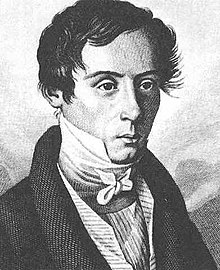Augustin-Jean Fresnel | |
|---|---|
 Portrait of "Augustin Fresnel" from the frontispiece of his collected works, 1866 | |
| Born | 10 May 1788 Broglie, Normandy, France |
| Died | 14 July 1827 (aged 39) Ville-d'Avray, Île-de-France, France |
| Resting place | Père Lachaise Cemetery |
| Education |
|
| Known for | |
| Relatives |
|
| Awards |
|
| Scientific career | |
| Fields | Physics, engineering |
| Institutions |
|
Augustin-Jean Fresnel[Note 1] (10 May 1788 – 14 July 1827) was a French civil engineer and physicist whose research in optics led to the almost unanimous acceptance of the wave theory of light, excluding any remnant of Newton's corpuscular theory, from the late 1830s [3] until the end of the 19th century. He is perhaps better known for inventing the catadioptric (reflective/refractive) Fresnel lens and for pioneering the use of "stepped" lenses to extend the visibility of lighthouses, saving countless lives at sea. The simpler dioptric (purely refractive) stepped lens, first proposed by Count Buffon [4] and independently reinvented by Fresnel, is used in screen magnifiers and in condenser lenses for overhead projectors.
By expressing Huygens's principle of secondary waves and Young's principle of interference in quantitative terms, and supposing that simple colors consist of sinusoidal waves, Fresnel gave the first satisfactory explanation of diffraction by straight edges, including the first satisfactory wave-based explanation of rectilinear propagation.[5] Part of his argument was a proof that the addition of sinusoidal functions of the same frequency but different phases is analogous to the addition of forces with different directions. By further supposing that light waves are purely transverse, Fresnel explained the nature of polarization, the mechanism of chromatic polarization, and the transmission and reflection coefficients at the interface between two transparent isotropic media. Then, by generalizing the direction-speed-polarization relation for calcite, he accounted for the directions and polarizations of the refracted rays in doubly-refractive crystals of the biaxial class (those for which Huygens's secondary wavefronts are not axisymmetric). The period between the first publication of his pure-transverse-wave hypothesis, and the submission of his first correct solution to the biaxial problem, was less than a year.
Later, he coined the terms linear polarization, circular polarization, and elliptical polarization, explained how optical rotation could be understood as a difference in propagation speeds for the two directions of circular polarization, and (by allowing the reflection coefficient to be complex) accounted for the change in polarization due to total internal reflection, as exploited in the Fresnel rhomb. Defenders of the established corpuscular theory could not match his quantitative explanations of so many phenomena on so few assumptions.
Fresnel had a lifelong battle with tuberculosis, to which he succumbed at the age of 39. Although he did not become a public celebrity in his lifetime, he lived just long enough to receive due recognition from his peers, including (on his deathbed) the Rumford Medal of the Royal Society of London, and his name is ubiquitous in the modern terminology of optics and waves. After the wave theory of light was subsumed by Maxwell's electromagnetic theory in the 1860s, some attention was diverted from the magnitude of Fresnel's contribution. In the period between Fresnel's unification of physical optics and Maxwell's wider unification, a contemporary authority, Humphrey Lloyd, described Fresnel's transverse-wave theory as "the noblest fabric which has ever adorned the domain of physical science, Newton's system of the universe alone excepted." [6]
- ^ J. Wells (2008), Longman Pronunciation Dictionary (3rd ed.), Pearson Longman, ISBN 978-1-4058-8118-0.
- ^ "Fresnel", Collins English Dictionary / Webster's New World College Dictionary.
- ^ Darrigol, 2012, pp. 220–223.
- ^ Cite error: The named reference
chisholm-1911-lighthousewas invoked but never defined (see the help page). - ^ Darrigol, 2012, p. 205.
- ^ Cite error: The named reference
lloyd-1841was invoked but never defined (see the help page).
Cite error: There are <ref group=Note> tags on this page, but the references will not show without a {{reflist|group=Note}} template (see the help page).